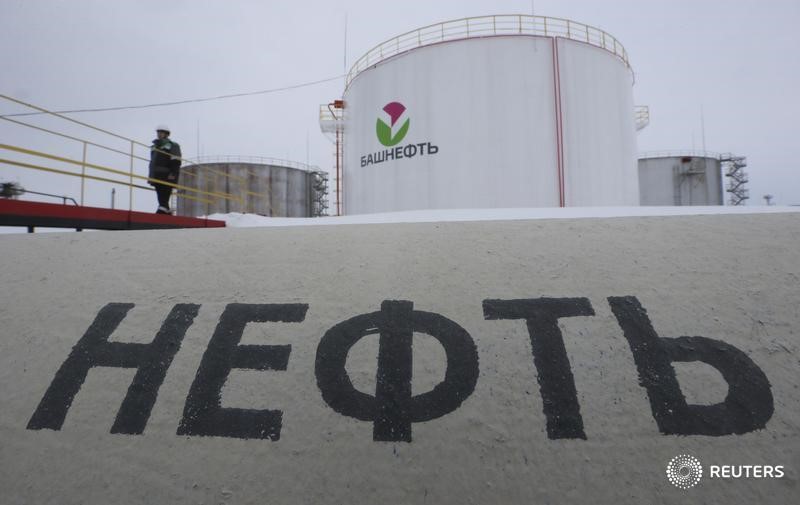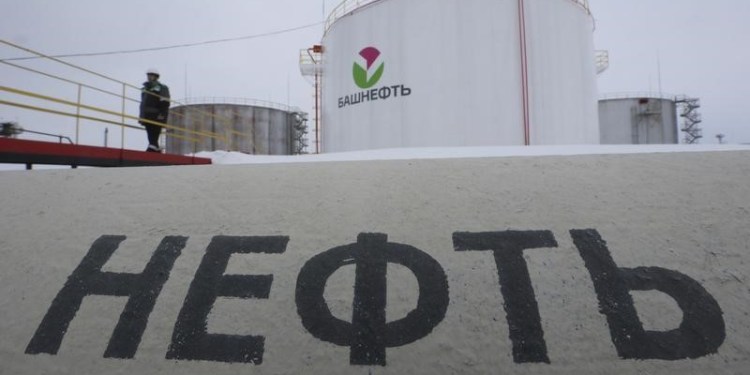
© Reuters.
LCO
-0.03%
Add to/Remove from Watchlist
Add to Watchlist
Add Position
Position added successfully to:
Please name your holdings portfolio
Type:
BUY
SELL
Date:
Amount:
Price
Point Value:
Leverage:
1:1
1:10
1:25
1:50
1:100
1:200
1:400
1:500
1:1000
Commission:
Create New Watchlist
Create
Create a new holdings portfolio
Add
Create
+ Add another position
Close
CL
+0.33%
Add to/Remove from Watchlist
Add to Watchlist
Add Position
Position added successfully to:
Please name your holdings portfolio
Type:
BUY
SELL
Date:
Amount:
Price
Point Value:
Leverage:
1:1
1:10
1:25
1:50
1:100
1:200
1:400
1:500
1:1000
Commission:
Create New Watchlist
Create
Create a new holdings portfolio
Add
Create
+ Add another position
Close
Investing.com — Crude prices headed on Friday for their first weekly loss in four after the Federal Reserve signaled it might raise interest rates again before the end of the year — and anytime inflation gets out of hand.
The downside in oil prices was, however, limited by Russia’s export ban on fuels, which counteracted fears that slowing economies and high interest rates could crimp demand for energy.
With 90 minutes to settlement, New York-traded West Texas Intermediate, or WTI, crude for delivery in November was at $90.17 per barrel, up 54 cents, or 0.6%, on the day. WTI earlier hit an intraday high of $91.31, after Tuesday’s 10-month high of $93.74. For the week, the U.S. crude benchmark was down 0.6%, after a cumulative gain of almost 14% over three weeks.
London-traded Brent was at $93.50 a barrel up, up 20 cents, or 0.2%. Brent rose to as high as $94.64 earlier on the day, after Tuesday’s 10-month high of $95.96. The global oil benchmark was down 0.6% on the week, after a cumulative gain of nearly 11% over three weeks.
The dollar strengthened after the Fed projected another quarter-percentage point rate increase by the year-end, despite leaving rates unchanged for September itself at a policy meeting on Wednesday.
“We are prepared to raise rates further, if appropriate,” Fed Chairman Jerome Powell told a news conference. “The fact that we decided to maintain the policy rate at this meeting doesn’t mean we have decided that we have or have not at this time reached that stance of monetary policy that we are seeking.”
Energy-driven inflation one of the Fed’s concerns
Powell said energy-driven inflation, led by the 30% rally in oil prices since June, was one of the Fed’s bigger concerns.
The Fed had raised interest rates 11 times between February 2022 and July 2023, adding a total of 5.25 percentage points to a prior base rate of just 0.25%.
Economists fear that the Fed’s renewed hawkish stance will dampen global growth though many also agree that a lid has to be put on oil prices if the Fed is to achieve its annual inflation target of 2%.
Russia said on Friday it has implemented an immediate ‘temporary’ suspension of gasoline and diesel exports to all countries except for four former Soviet states and its own overseas military bases, with the goal of stabilizing its domestic market.
Kremlin fuel export ban will further tighten oil market
The Kremlin said the ban was “temporary” and designed to address rising energy prices in Russia. Russian wholesale gasoline prices were down nearly 10% and diesel down 7.5% on Friday after the ban.
The ban will “bring new uncertainty into an already tight global refined product supply picture and the prospect that the impacted countries will be seeking to bid up cargoes from alternative suppliers,” RBC said in a note.
Diesel is the workhorse fuel of the global economy, playing a crucial role in freight, shipping and aviation. Derivatives of diesel such as heating oil are particularly susceptible to winter price surges. Germany and the north-east of the U.S. are both heavily reliant on the fuel for heating homes.
Russia is the world’s second-largest seaborne exporter of diesel after the U.S., according to Kpler, a freight data analytics company, and before its invasion of Ukraine was the single biggest diesel exporter to the EU. The EU and U.S. have largely banned imports of Russian refined fuel since February, forcing Moscow to reroute its sales to Turkey and countries in North Africa and Latin America.
Russian refined fuel sales, particularly diesel, remain a critical part of oil supplies. In August Russia exported more than 30mn barrels of diesel and gas-oil — a diesel proxy — by sea, according to oil cargo tracker Kpler.
Source: Investing.com




























